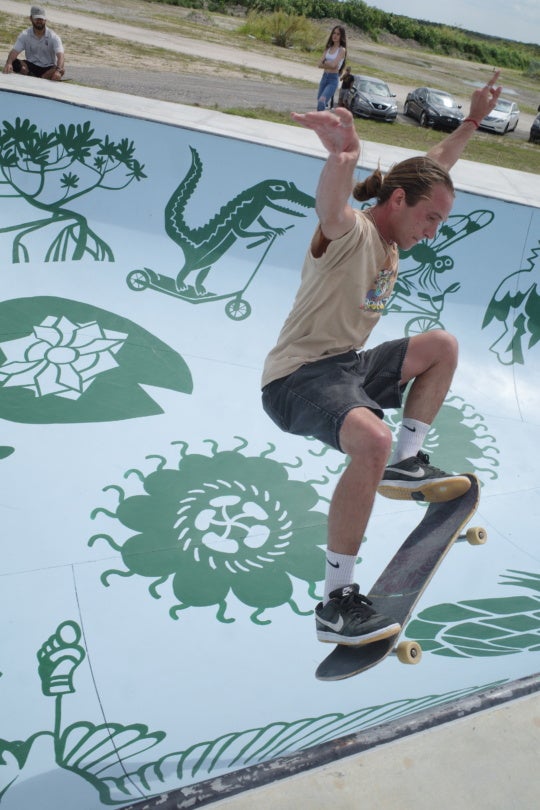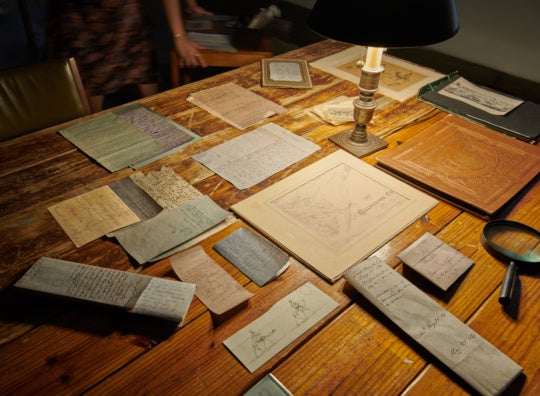
A painting can be so many things. It may reassert the materials and the process that went into its making, or act as an illusory window, providing a three-dimensional view into a world we already know. It may suggest things that are impossible to say, or haven’t yet been thought to say, with words. A painting may also create a unified view into an alternative universe, a portal to a place of daydreams and magic. This is the case with paintings by Anna Podris, an artist based in Raleigh, NC, who works primarily in oil and encaustic, and whose art presents a place where animals inhabit as much space as people.
Podris’s website offers a tantalizing list of the subjects she paints: fish, birds, owls, dreams, and nature. Dreams could cover any of the other categories as she envisages each subject through the lens of her own whimsical style. Her scenes have the effect of charmed escape, where daydreams rule over reality. In Head in Cloud, tall Victorian homes with ornate rooflines lean toward each other. Cats and pensive woman gaze from the windows, and in the foreground a tram moves along a schematic raised track. Butterflies and birds, not to scale with the architecture, flutter between the buildings. Welcome to Woodland also presents a memorable scene with buildings and out-of-scale birds.

Podris agrees that, in some cases, her buildings have more personality than the people: “I definitely think the architecture in my paintings is personified. Sometimes I have tried to make subtle faces appear by the placement of windows and ornaments.” Her paintings are lush, colorful worlds, complete with friendly subjects—such as flowers, animals, and sweet faces—and linear ornamentation portraying imagery that is often relegated to the realm of children’s books and illustration.
Many contemporary artists tread both worlds, such as August Wren and Monika Forsberg, whose works have similar rainbow palettes and surreal, fanciful subject matter. When considering where her work falls on a continuum of fine art to illustration, Podris said, “I think the lines are blurring now more than ever, and that is great. I think with the proliferation of stock images, the traditional field of illustration has taken a hit. Maybe that has pushed illustrators into the world of fine arts. I think the difference is in the mind of the artist. An illustration is for a specific purpose and it’s a different mindset. Although fine art also aims to communicate, it is not always as tangible in the artist’s mind.” The finished result often offers more questions than answers.
Podris often uses the iconic composition of the portrait bust as a point of departure for depicting mystical visions. Geometric forms or rainbow stripes radiating from the crown of a head give visual forms to the thoughts or moods of her subjects, as in Birds of Passage. The women she paints—and they are always women—are not specific people, and she considers them self-portraits only in the sense that all art is somewhat a portrait of the artist. “They are symbolic of themes that were running through my mind and my life when I painted them,” she says. “It is important to me that they seem self-assured.”

She creates comparable images of birds and buildings. In Green Bird’s Headspace, an ornate mandala of diamonds radiates from the customary black beady eye. Black lines form the mandala and outline the bird’s body and beak. The feathers are a marbleized blend of colors, a contrast to the texture of the bright, flamelike colors that radiate around it. Meanwhile, in Ghost House, a mass exodus of ghosts departs a black house and swirls toward a white one, but that drama is nearly overshadowed by the ornate patterns of the homes’ doorways and windows. The pattern and decoration is a part of the inventive narrative. Similarly, in Birds and Berries, five red birds stand on divided grounds, one half white and yellow, and the other mint green and black. Their lashed blue and green eyes meet our gaze with wizened clarity.
Although her representations take fanciful departures from reality, such as humanlike bird eyes, the observation of nature means a great deal to Podris. She teaches a class each summer at Artspace, a nonprofit arts center and open-studio environment where her studio is located. The popular weeklong class includes a visit to the North Carolina Museum of Natural Sciences and teaches the use of observation to enhance drawing skills. Podris’s artwork blends representation and symbolic, illustrative invention, demonstrating a meeting of interior and exterior, vision and mind.
This summer, she is focusing on oils: “I’m pretty sure this is a temporary respite from encaustic. I felt I needed a change in medium to break up some stagnation I was having.” She usually does not use encaustic in the same works as oils, but with a series of women’s faces, she began with an oil background to achieve a smooth color transition as she built the surface. “I don’t always start an encaustic piece that way,” she explained. “And I don’t paint oil on top of my encaustics because the wax is too fragile a base for the oils, and they are prone to scratching.” Her encaustic works on panel compose about 70 percent of her output, and, notably, Podris successfully mixes media in order to incorporate figures in encaustic paintings.
Most accomplished, contemporary encaustic art is abstract, whether geometric or reductive. Compelling contemporary encaustic work is often sculptural, as in the work of Laura Moriarty, who stacks and fuses the wax into steep, rugged outcroppings, creating a rainbow-hued geology. Other standout fine art made with wax focuses on color, like Joanne Mattera’s well-received “Silk Road” series. Complex scenes containing figures rarely succeed in encaustic, and when they do, another medium such as oil or acrylic can better summon the delicate variations in shade and light required to create a face.
Podris uses layers to help build her figures in encaustic. Over a smooth base layer of wax medium, she adds a transfer of a drawing, most often her own. Then, she adds more wax. The transfer drawings float between layers of color, providing the distinctness that is absent in much figuration done in encaustic.

In Eternal Return, three different textures coexist: the grainy background, the smooth skin of the central subject, and the crisp lines that encircle the woman’s head, form the little feet of the birds, and give structure to her hair. The lines are fluid and retain the sense of a sketch, which, with the textures and the vibrant colors, brings about a much expressive effect. Podris plunders the misty and gemlike qualities of encaustic paint to make her dreamlike subjects all the more otherworldly.
This August, Podris is exhibiting her entire collection of sketchbooks with her studio mate and husband, Keith Norval at Artspace in Raleigh, NC. Her work was recently on view at the Chamblin Bookmine in Sarasota, FL; as part of the collaborative Slowboil at Ahpeele Studios, Raleigh, NC and at the Cary Arts Center, Cary, NC.
Shana Dumont Garr recently relocated from Raleigh, North Carolina, to the Boston area, where she is an independent arts writer and director of Kingston Gallery in Boston’s South End.




